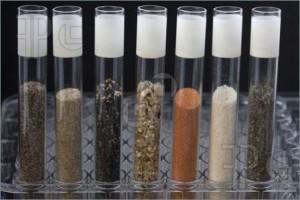SAND TESTING
Molding sand and core sand depend upon shape, size composition and distribution of sand grains, amount of clay, moisture and additives. The increase in demand for good surface finish and higher accuracy in castings necessitates certainty in the quality of mold and core sands. Sand testing often allows the use of less expensive local sands. It also ensures reliable sand mixing and enables a utilization of the inherent properties of molding sand. Sand testing on delivery will immediately detect any variation from the standard quality, and adjustment of the sand mixture to specific requirements so that the casting defects can be minimized. It allows the choice of sand mixtures to give a desired surface finish. Thus sand testing is one of the dominating factors in foundry and pays for itself by obtaining lower per unit cost and increased production resulting from sound castings. Generally the following tests are performed to judge the molding and casting characteristics of foundry sands:
1. Moisture content Test
2. Clay content Test
3. Chemical composition of sand
4. Grain shape and surface texture of sand.
5. Grain size distribution of sand
6. Specific surface of sand grains
7. Water absorption capacity of sand
8. Refractoriness of sand
9. Strength Test
10. Permeability Test
11. Flowability Test
12. Shatter index Test
13. Mould hardness Test.
Some of the important sand tests are discussed as under.
1 Moisture Content Test
The moisture content of the molding sand mixture may determined by drying a weighed amount of 20 to 50 grams of molding sand to a constant temperature up to 100°C in a oven for about one hour. It is then cooled to a room temperature and then reweighing the molding sand. The moisture content in molding sand is thus evaporated. The loss in weight of molding sand due to loss of moisture, gives the amount of moisture which can be expressed as a percentage of the original sand sample. The percentage of moisture content in the molding sand can also be determined in fact more speedily by an instrument known as a speedy moisture teller. This instrument is based on the principle that when water and calcium carbide react, they form acetylene gas which can be measured and this will be directly proportional to the moisture content. This instrument is provided with a pressure gauge calibrated to read directly the percentage of moisture present in the molding sand. Some moisture testing instruments are based on principle that the electrical conductivity of sand varies with moisture content in it.
2 Clay Content Test
The amount of clay is determined by carrying out the clay content test in which clay in molding sand of 50 grams is defined as particles which when suspended in water, fail to settle at the rate of one inch per min. Clay consists of particles less than 20 micron, per 0.0008 inch in dia. Copied from A Taxtbook of a Basic Manufacturing Processes and Workshop Technology by Rajender Singh.













Post Comment
You must be logged in to post a comment.